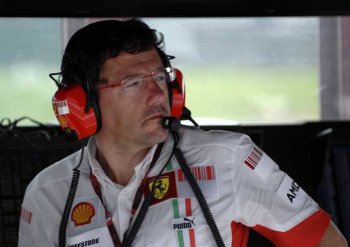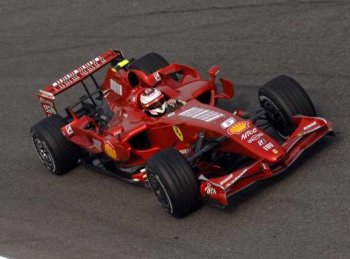|
"Monza was new
to me when I joined Ferrari as in my younger days I was
always trying to jump over the fence to get into Imola which
was my home track." So says, Scuderia Ferrari Marlboro's
Head of Race Track Engineering, Luca Baldisserri. "I have
been with Ferrari since 1989 and I think I started attending
the Italian Grand Prix every year apart from that first one.
Until last year, Monza was one of two home races for us in
Italy, whereas this year, without the appointment at Imola,
it is the only one. That means we can expect more pressure
than usual, as there is only one chance to get a good result
at home."
Facing a tough challenge at Monza is nothing new for
Baldisserri, who has experienced it all in the royal park in
over a decade of races during which time he worked as a race
engineer to several of the Scuderia's drivers. "Good
memories came in 2000, when we turned the championship
around with Michael (Schumacher) when we had four races to
go and we had to win them all," he recalls. "And that's what
we did. Monza was a key point, as this was the race where we
started to change our approach to setting up the car and it
paid off for the championship. Then we had a bad weekend the
following year in 2001, when it was the weekend immediately
after the events of 9/11 and emotions were running high in
the paddock. Going further back to the days when Jean (Alesi)
and Gerhard (Berger) were our drivers, we were always
struggling a bit and never had a good car for Monza. We
could never get a decent pace on our own home track. Last
year in Monza was also a very emotional race day. Michael
won the race and it was then that he announced he was
retiring. He told the whole team over the radio after he had
taken the flag that he would be retiring at the end of the
year. To be honest, the rumours had already been circulating
for a while, but for some of the guys it was a big surprise
and I remember tears in the eyes of some of the mechanics.
Michael had been with us for ten years and there were people
in the team who had never experienced working without him.
Having him as a driver was a normal thing, he was part of
the furniture. It was a sad moment but we were happy for him
that he had found the right equilibrium. It was also
emotional for him. He took a long time to speak afterwards
and his speech was very slow and full of emotion. Looking to
the future and this weekend, Kimi is usually quite quick at
Monza and he had pole last year, but he was a bit lighter
than us and we managed to jump him at the pit stop."
Whatever the memories, it is this weekend and the unique
challenge of the circuit that Baldisserri is focussed on
now. "I think Monza is a great track, completely different
to all other venues on the calendar and it requires a
special aerodynamic setting that we use nowhere else," says
the Ferrari man. "It has its characteristic very long
straight and is a low downforce circuit. We were able to
tune our set-up for this special configuration at last
week's Monza test. To be able to do that is quite important,
not only for the cars but also for the drivers, who are not
used to seeing such high speeds before braking for such low
speed corners such as the chicane. This means they have to
tune themselves in as well as the cars. For example, I
remember that Eddie Irvine was unable to drive at a Monza
test and over the next race weekend it was difficult for him
to get a decent pace immediately at the start of practice.
Indeed the braking is another aspect of the package that
requires a special focus at Monza.
|

 |
|
Kimi Raikkonen (above
during the official F1 testing sessions at Monza
last week) was on pole position in last year's
Italian Grand Prix. He will be targeting a win in
Ferrari's 'home' F1 race. |
|
|

 |
|
Luca Baldisserri (top)
has been with Scuderia Ferrari for 18 years. Kimi
Raikkonen (above during official F1 testing at Monza
last week) always goes quickly in the Italian Grand
Prix. |
|
|
We need a specific cooling arrangement and special brake
material because of the high energy we need to dissipate.
The high speed nature of the circuit is not the only special
challenge provided by this track. "Until four or five years
ago, we had the chicane with very high kerbs which meant it
was important to have a car that could cut the kerbs as this
was a way of reducing lap times," says Baldisserri. "We
needed to tune the set-up in order to compromise ride height
and stiffness to allow drivers to cut the kerbs and gain
time. With the new chicanes, the first chicane is no longer
so important, but the kerbs are still difficult at Roggia,
the second chicane, so we still need to give some thought
about a special set-up for this."
While the F1 drivers love the opportunity this track
provides to drive at very high speeds, the circuit layout
can lead to a somewhat processional Sunday afternoon.
"Unfortunately, if cars are very evenly matched in terms of
performance, overtaking will be very difficult," agrees
Baldisserri. "Unless someone runs into problems with tyres
so that he cannot approach the exit of the second Lesmo or
the Parabolica in a decent way, the car in front of you is
hard to pass. This means you often see a "train" at Monza.
However, unlike tracks like Hungary for example where even
if you have an advantage from your car, you cannot pass,
here at Monza, a car advantage can help. If you have a good
car but run into problems in qualifying and have to start
near the back, Monza is a place where you can still gain
position."
In the past, a variety of pit stop strategies were viable at
this race, but that is no longer the case. "With the
reduction of the speed limit in pit lane, the penalty of
making an additional pit stop is now higher," reckons
Baldisserri. "So, depending on tyre consistency, we could
see less pit stops. Three stops will no longer be an option.
The other way one can gamble is on the probability of having
a Safety Car period, which is heightened by the fact the
cars have very low downforce and there are some big kerbs,
which can raise the chances of accidents. Normally, the most
likely time to have a Safety Car on track is after the start
of the race, when drivers are fighting for position or
around the pit stop window, when the tyres are older or
someone on new tyres is fighting with someone on old ones.
With this year's SC rules, get it wrong and it can be a
disaster, because you cannot just pit when you want, refuel
and change strategy. So I think this will see people play
around with the idea of just one stop."
In the past, working as a race engineer, Baldisserri's
loyalties were biased towards one driver, but his current
responsibilities take in both sides of the pit garage.
"These days I am just happy if Ferrari wins rather than
having a strong emotion for one driver," he says. "But I see
the face of the "losing" race engineer if the other car has
won and I remember that feeling! Now for me it is different
especially at the moment, as we try to regain championship
points and get first and second in every race."
|
|
|
|